The ancient sanctuary of Claros (aka Klaros), located just north of present-day Ahmetbeyli, was renowned in antiquity primarily for its oracle of Apollo. It played a significant role as a religious and cultural centre from the early periods of Greek colonisation through the Roman and Byzantine eras.
Getting there: 2km north of Ahmetbeyli and 130km southeast of Çeşme in the province of İzmir via D550 & Sahil Cd. 1.5-hour drive by car via İzmir and Menderes or a 2-hour drive via Urla and Seferihisar. A visit to Claros could be combined with a day trip to the Ancient City of Teos and the Seferihisar Thermals or as a stop-over on the way to the Ephesus Ancient City.
Map location & entry: Claros Antik Kenti – Ahmetbeyli, Işıklı Klaros Cd. No:33, 35470 Menderes/İzmir – Open daily summer (1 April – 1 October) 08:00-19:00, winter (1 October – 1 April) 08:30-17:30 – Free entry. The site is on a floodplain and, particularly during the spring may be difficult to access.
Claros Ancient Sanctuary – Table of Contents
Brief History of Claros
Fragments of Protogeometric pottery found in Claros date back to the 10th century B.C. and a holy cave near the temple of Apollo is believed to have been a place of worship for the goddess Cybele before the arrival of Greek settlers.
Claros was established as a sanctuary and oracle site (a portal through which the gods spoke directly to people) during the early Greek colonisation of the region between the 8th and 6th century B.C., becoming one of the most significant oracles dedicated to Apollo, comparable to the oracle of Delphi. According to some scholars, Homer was born circa 8th century B.C., in nearby Colophon (near current Değirmendere 15km north), and a collection of 33 anonymous ancient Greek poems celebrating the gods of the Greek pantheon is attributed to him. During the Classical and Hellenistic periods (5th to 2nd century B.C.), the sanctuary saw significant development, with the construction of major buildings and temples dedicated to Apollo, Artemis, and other deities. Claros attracted pilgrims from across the Greek world who sought guidance from the oracle—the Hellenistic period marked a peak in activity and architectural development, with contributions from various Hellenistic rulers, including Alexander the Great (356-323 B.C., reign 336-323 B.C.).
From the 2nd century B.C. to the 3rd century A.D., Claros flourished as a religious centre during the Roman Period. The site was embellished with Roman architectural styles, and the oracle remained influential with emperors and prominent citizens who consulted it. In Claros, the Roman general Germanicus (15 B.C.-19 A.D.), the adopted son of the Roman emperor Tiberius, learned in Claros of a dark fait and died the following year in dubious circumstances due to illness or poisoning. In late Antiquity, from the 4th century A.D. onwards, with the rise of Christianity, the significance of pagan oracles declined, and Claros gradually lost its prominence. The sanctuary fell into disuse, and the site was largely abandoned by the Byzantine period and was covered by river sediments.
The Temple and Altar of Apollo
The Temple of Apollo, built between the 4th and 3rd centuries B.C., was revered locally as Apollo Clarius and was the most central and important structure in Klaros. Every five years, a sports event, known as Claria, was organised in honour of Apollo and held in Claros. Only fragments of columns and the foundation remain, but they indicate the temple’s former magnificence. Modifications to the building were made during the reign of Emperor Hadrian (76-138 A.D., reign 117-138 A.D.). The temple was built on a rectangular plan 26 x 46 metres, along its sides stood 11 columns, with 6 columns on the shorter side. The drums of these columns are up to 1.6 meters in diameter.
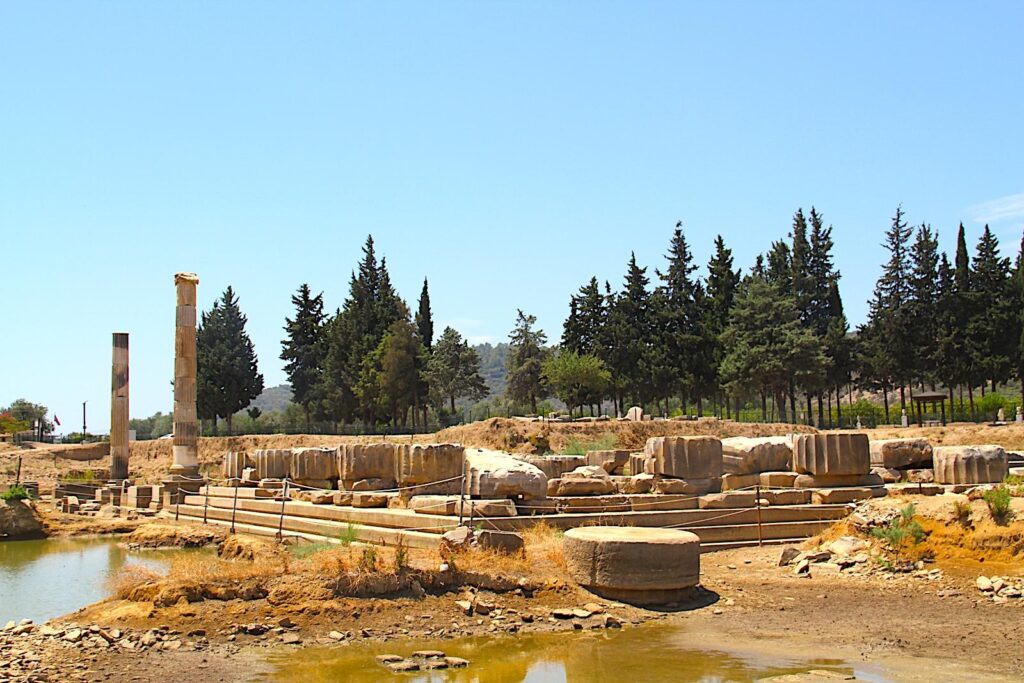
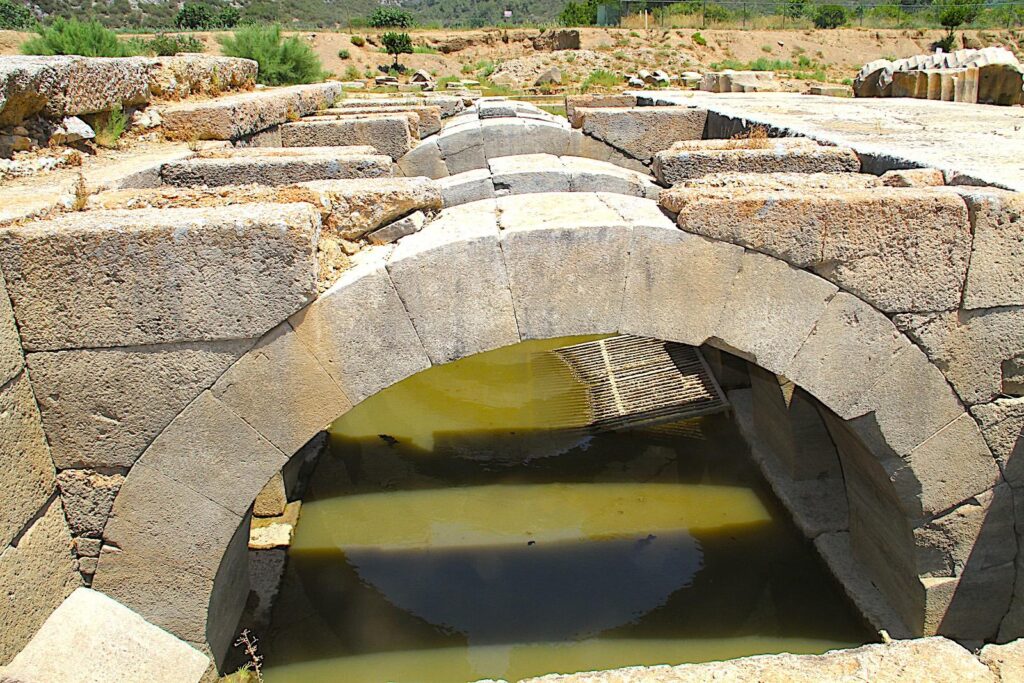

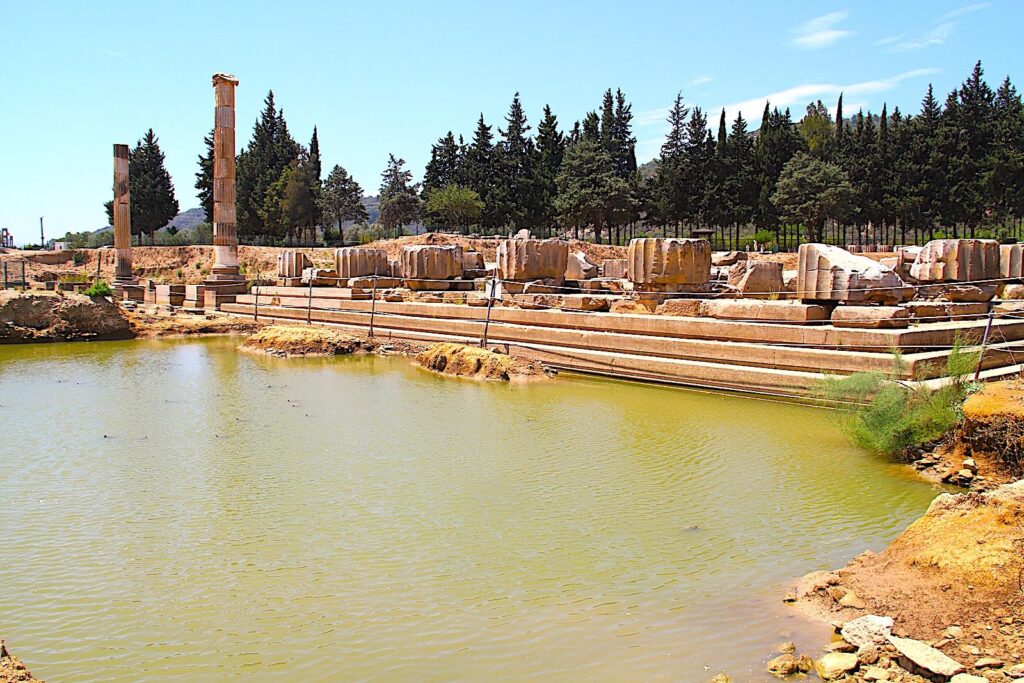
The Hellenistic altar of Apollo has a rectangular plan of 9 x 18 metres and is located about 30 metres to the east of the temple. As evidenced by sacrificial tablets, sacrifices were made here not only to Apollo but also to Dionysus.

The Temple and Altar of Artemis
The Temple of Artemis followed the typical Greek temple architectural style, incorporating elements of the Ionic order, which was prevalent in the region. The temple had a rectangular floor plan with a pronaos (front porch), a cella (main chamber), and an opisthodomos (rear room). Columns adorned the façade and possibly the sides of the temple. The temple was a place of worship dedicated to Artemis, the goddess of the hunt, wilderness, and childbirth. It housed a cult statue of Artemis where devotees would offer prayers and sacrifices. The temple was strategically placed within the sanctuary complex of Claros, complementing the primary worship of Apollo its presence underscoring the interconnected worship of the twin deities, Apollo and Artemis.
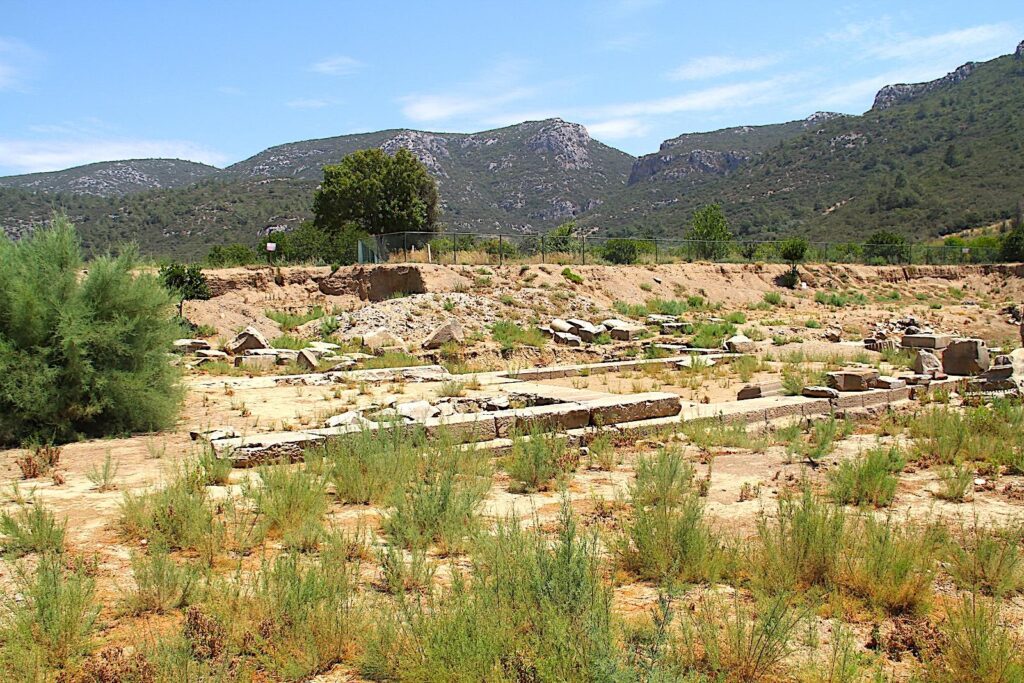
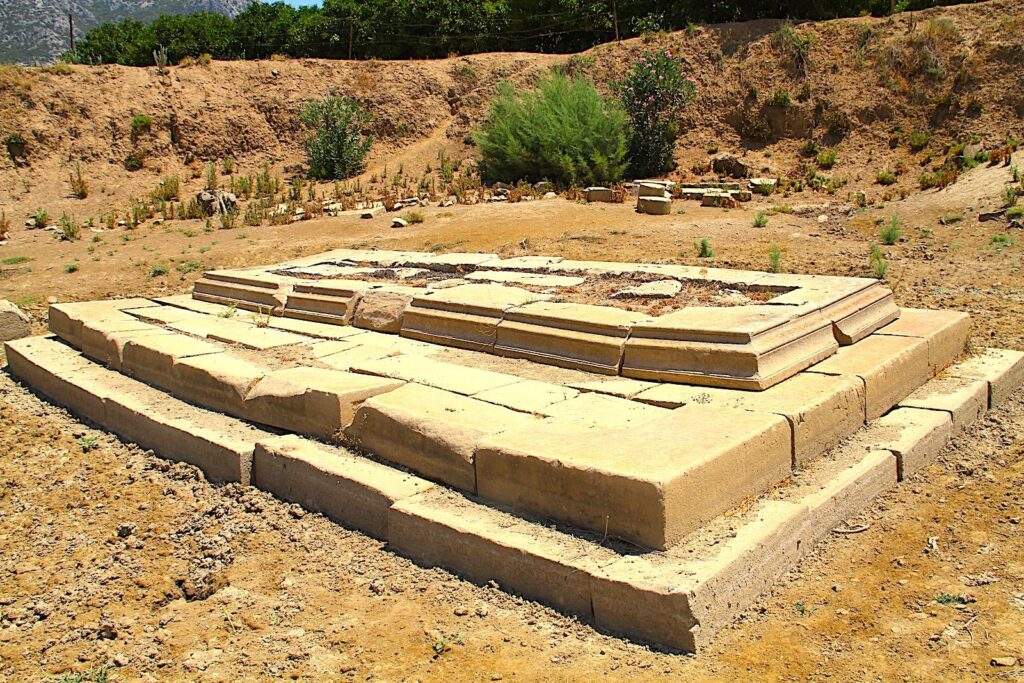
The Altar of Artemis was a raised platform, designed to facilitate animal and possibly vegetal sacrifices. Made of stone, with steps leading up to the sacrificial area the altar would have been decorated with reliefs or inscriptions related to Artemis, depicting scenes from mythology or symbolic representations of her dominion.
The Sacred Way
During religious festivals and ceremonies, a processional route lined with statues and inscriptions connected the temple complex to other parts of the sanctuary. The entrance to the sanctuary in Claros was through the sacred road and the monumental gate (propylon). It was built in the 2nd century B.C. on a square plan in the Doric order consisting of six columns, on which the inscriptions were carved. They contain the lists of delegations arriving to consult the oracle and the names of young choristers who sang the hymns in honour of Apollo.
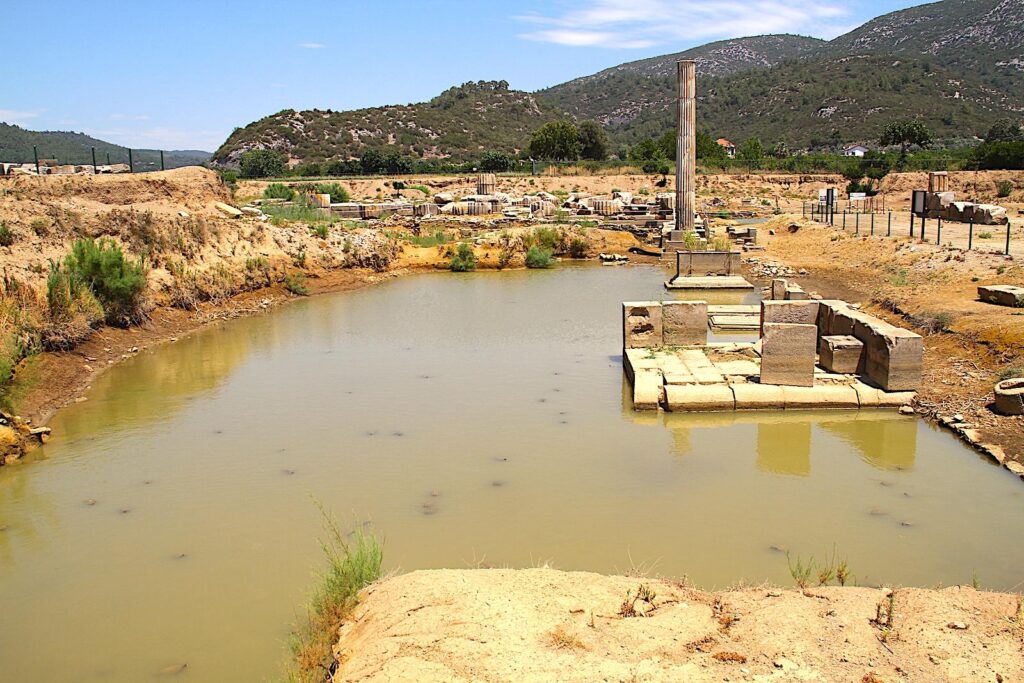
Altars and Inscriptions
Numerous altars are dedicated to various deities, reflecting the sanctuary’s religious diversity. Inscriptions found at the site provide valuable information about the individuals who visited and the questions they posed to the oracle.
The honour monument located on the eastern side of the Hellenistic ancient road is dedicated to Kolophonian Polemaios is dated to the late 2nd century A.D. Polemaios came from a famous family of Kolophon and served as a priest in Apollo Klarios, acting as the Agonothetes (ancient Greek superintendent) at the Klaria Festivals held every five years. A blue marble high square base was found on the northeast side of the Propylon. Two drums and an Ionic capital were found in 2003 and an inscription note’s that a gold-plated bronze statue was on top of the column. The monument was reconstructed in 2017.
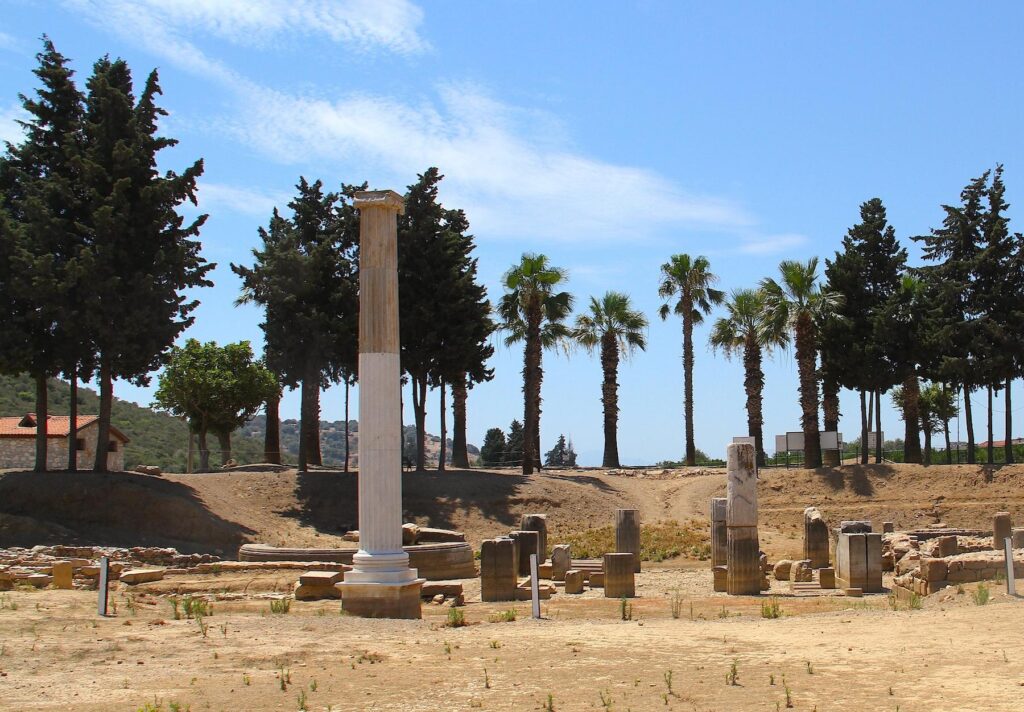
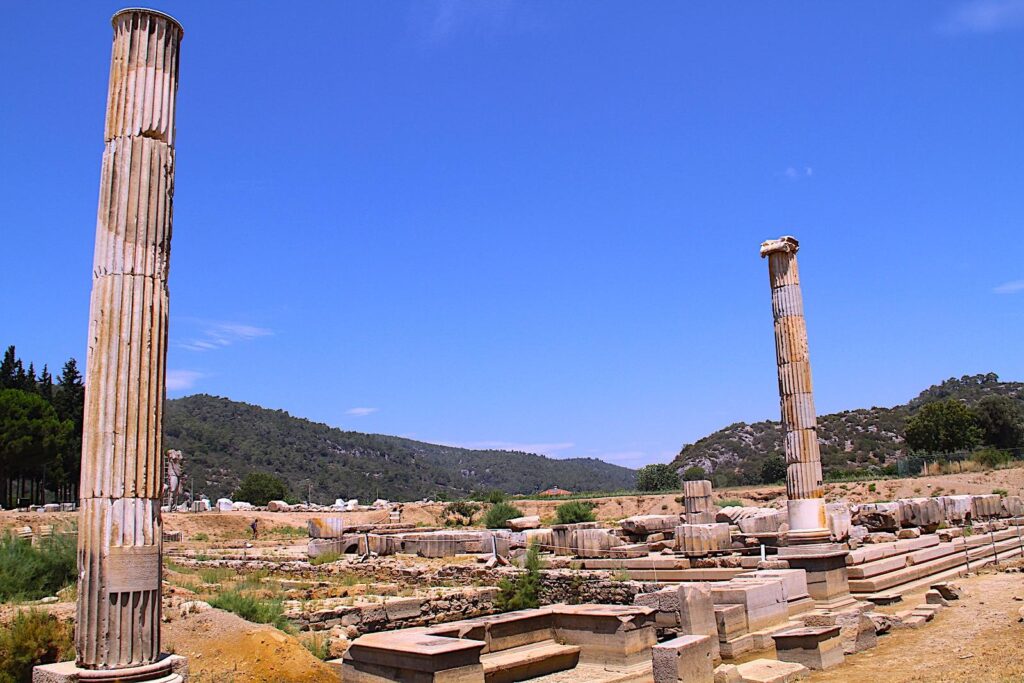
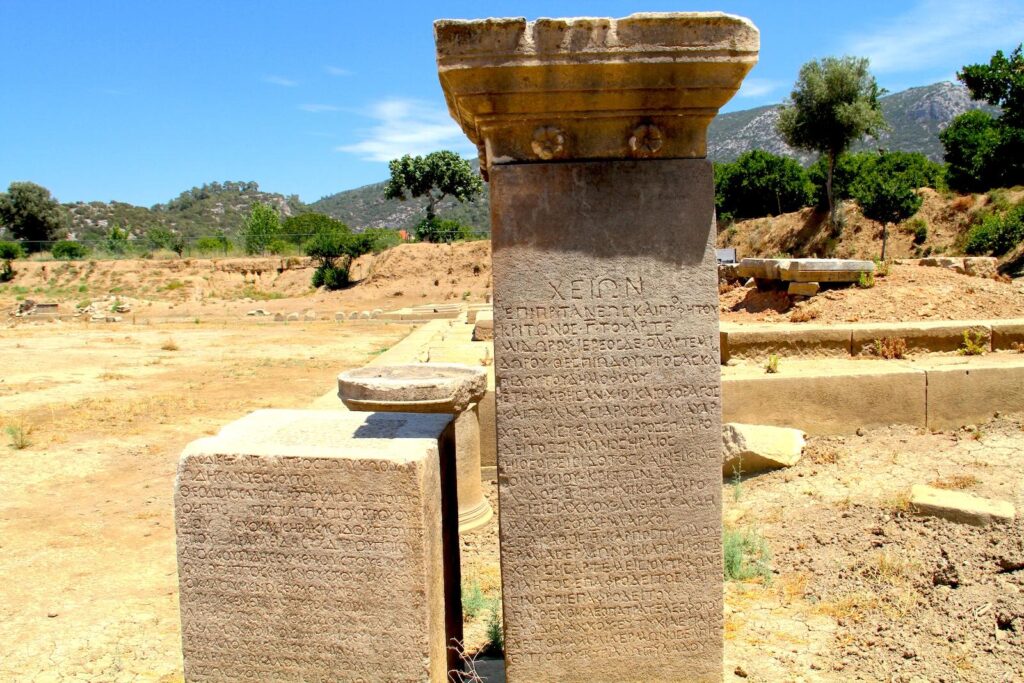
Other Structures and Finds in Claros
Smaller temples and buildings remain, possibly used for administrative purposes or as accommodations for priests and pilgrims. One such building is a theatre or assembly area where people gather for announcements and oracle proclamations.
The Katagogeion was designed to accommodate many visitors and consisted of multiple rooms arranged around a central courtyard like a hostel. The rooms were likely simple in design, providing basic shelter, a kitchen and bathing facility for the pilgrims. The primary function of the Katagogeion was to serve as a guesthouse to the sanctuary for visitors from across the ancient world. Pilgrims often had to wait for their turn to consult the oracle, so having a place to stay was essential and its proximity to the temple facilitated the participation of pilgrims in religious rites and consultations with the oracle. It would have been necessary to reserve a bed at the Katagogeion and payment was required. An inscription states a precondition for consultation is that each delegation required at least seven ladies and seven men, so delegations were likely in the size of approximately 20 people.
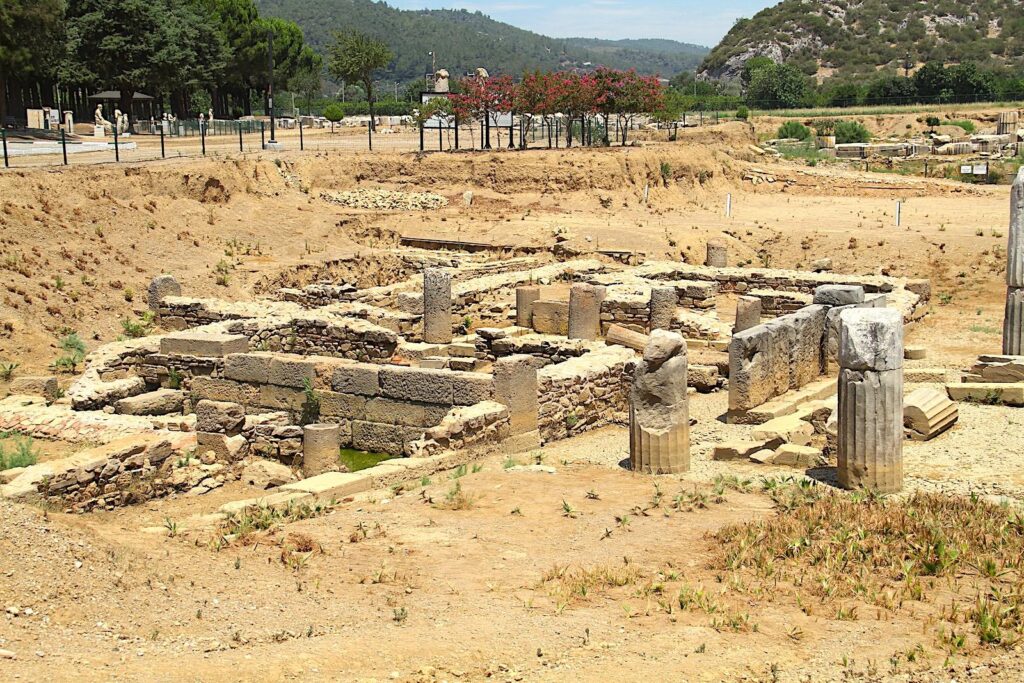
The protocol seat (proedria) of the theatre was discovered in 1958, the original seat is on display at the İzmir History & Art Museum, the seat on site is a replica. Another replica on the site and in display at the İzmir History & Art Museum is an Hellenistic Sundial found in 1957. On the base of the sundial is inscribed “Athenagoras son of Apollas being agoranomos, offered to Dionysos and to the people”. An agoranmous was an elected official who was in charge of order in an agora (marketplace).
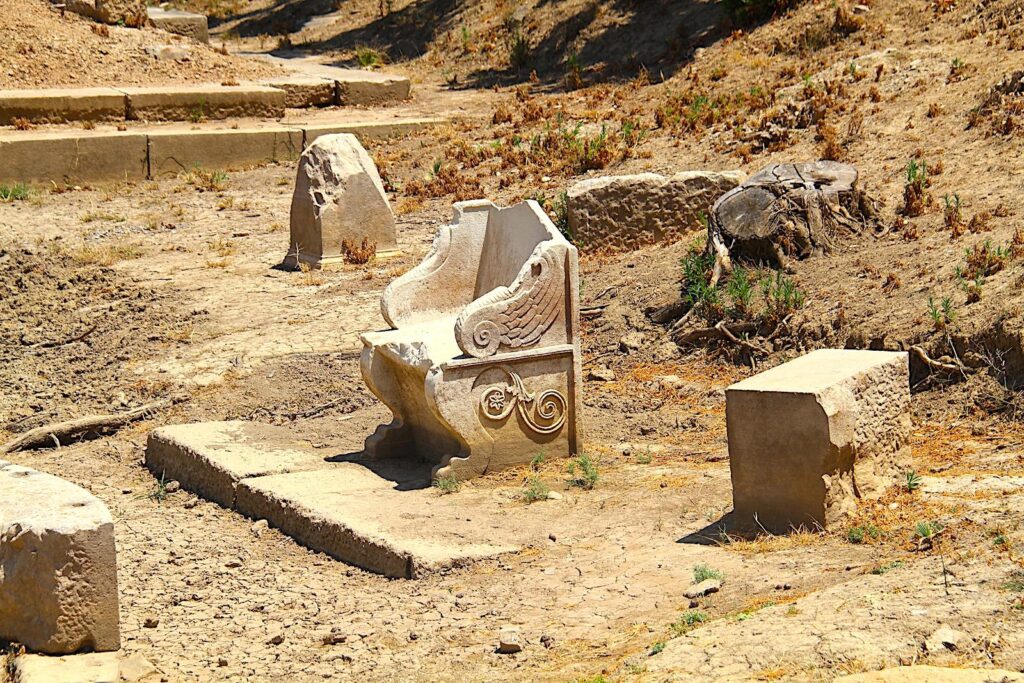
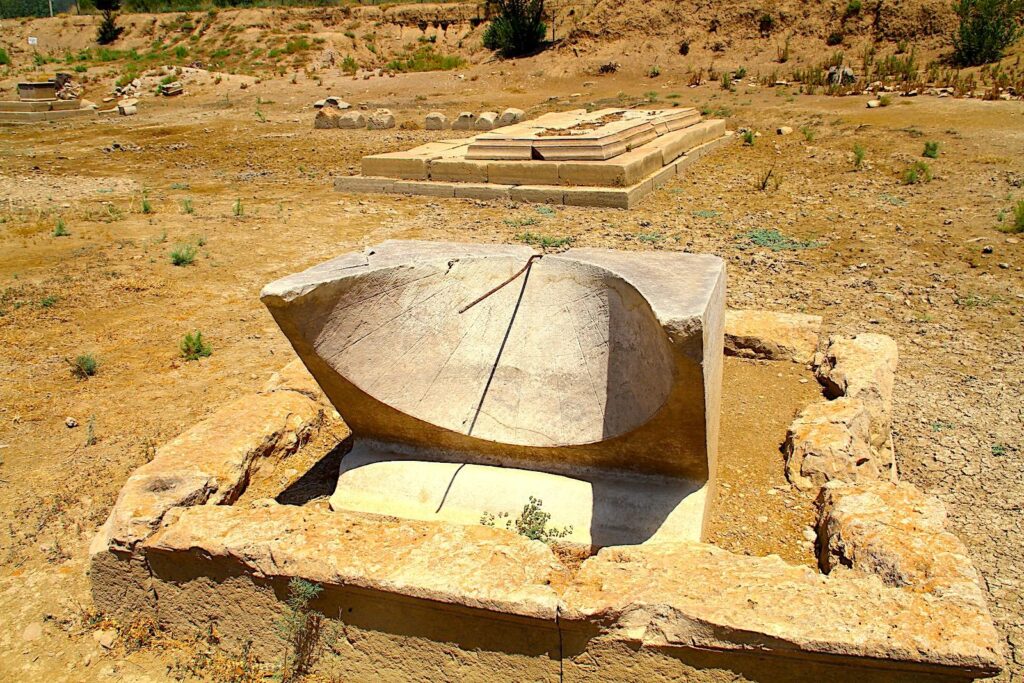
Statues at Claros
The statues at Claros, particularly those associated with the sanctuary of Apollo, are significant artifacts that offer insights into the religious, cultural, and artistic heritage of the site. As the central deity of the sanctuary, statues of Apollo were prominent. These statues typically depicted him as a youthful and athletic figure, often holding a lyre or a laurel branch, symbols associated with his divinity. Besides Apollo, statues of other gods and goddesses, such as Artemis (Apollo’s sister) and Dionysus, were also present, reflecting the broader pantheon worshipped at Claros. The statues at Claros exhibit the classical Greek style, characterised by idealised beauty, balanced proportions, and lifelike realism. The statues were typically made from marble and bronze, showcasing advanced sculpting techniques and intricate detailing. The statues served religious functions, acting as focal points for worship and offerings. They were placed in prominent locations within the sanctuary, such as the temple precinct, altars, and sacred groves. Some statues were erected as votive offerings by pilgrims and patrons, commemorating their devotion or seeking favour from the gods and inscriptions on the statues often recorded the names of donors and the purpose of the dedication.
Archaeological excavations have uncovered several colossal statues, including a significant one of Apollo. These large-scale statues would have dominated the sanctuary’s landscape, reflecting the grandeur and importance of the site. Many fragments of statues and reliefs depicting mythological scenes, deities, and ceremonial activities have been discovered. Many of the statues and fragments excavated from Claros are now housed in museums, such as the İzmir Archaeological Museum, where they are preserved and displayed for public viewing. The statues at Claros are either recently unearthed or copies of the originals set for context on the ancient site.
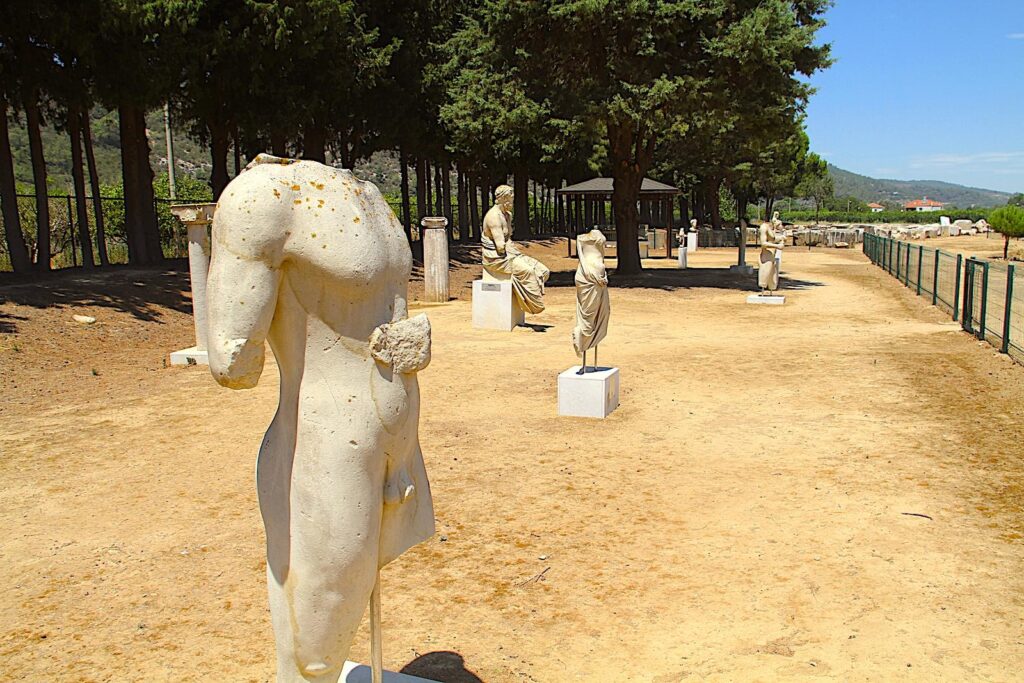
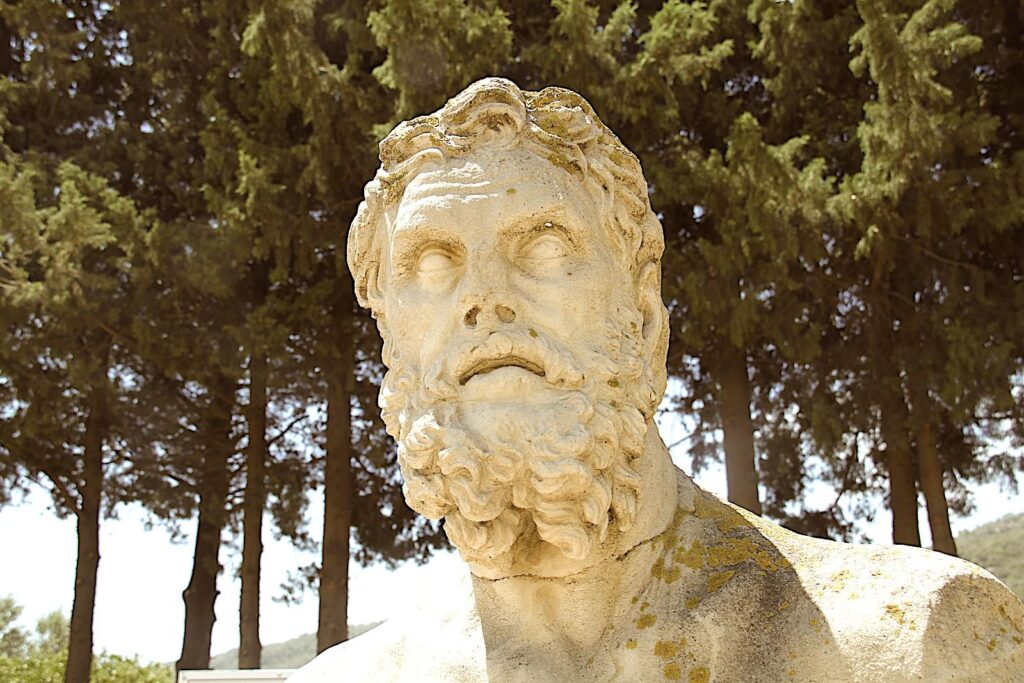
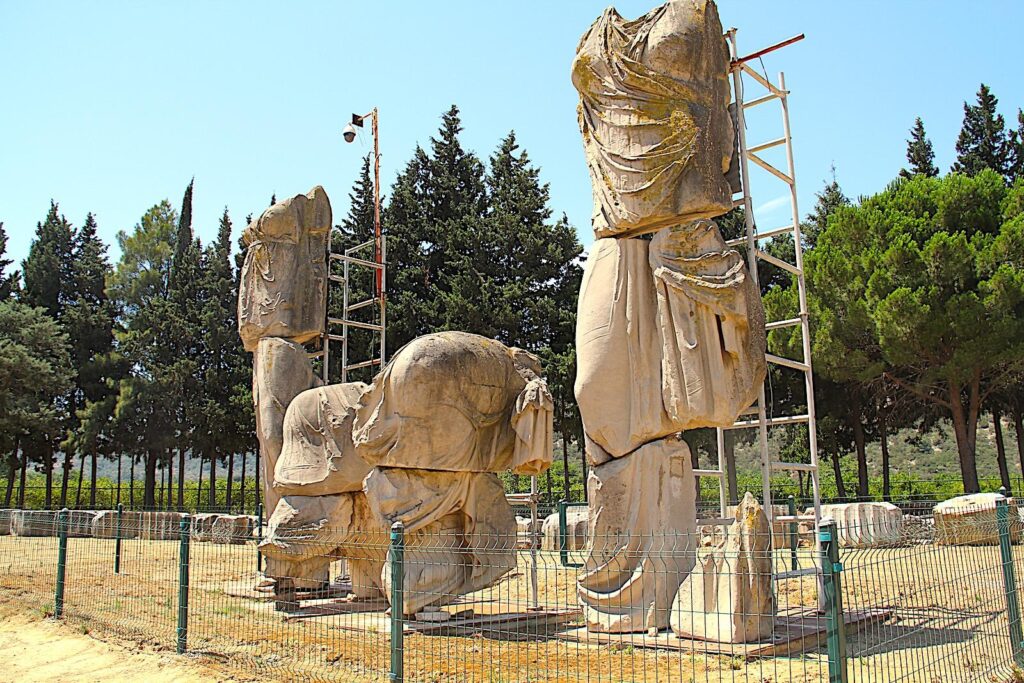
Archaeological Research in Claros
Ottoman archaeologist Theodore Macridy (1872-1940) discovered a single column in 1904 using information obtained from local shepherds. A detailed study was conducted together with Classical archaeologist Charles Picard (1883-1965) in 1913, and excavations at Klaros commenced until the outbreak of World War One. Further excavations occurred in 1950-1961 and uncovered the Temple of Apollo, monumental statues of Apollo, Artemis and Leto, the east altars, a sundial and a stone seat. A third round of excavations was made between 1988 and 1997 under Juliette de La Genière (1927-2022), a French archaeologist, and the fourth under Nuran Şahin from 2001 to today. The site remains particularly important for studying ancient Greek religion and oracular practices.
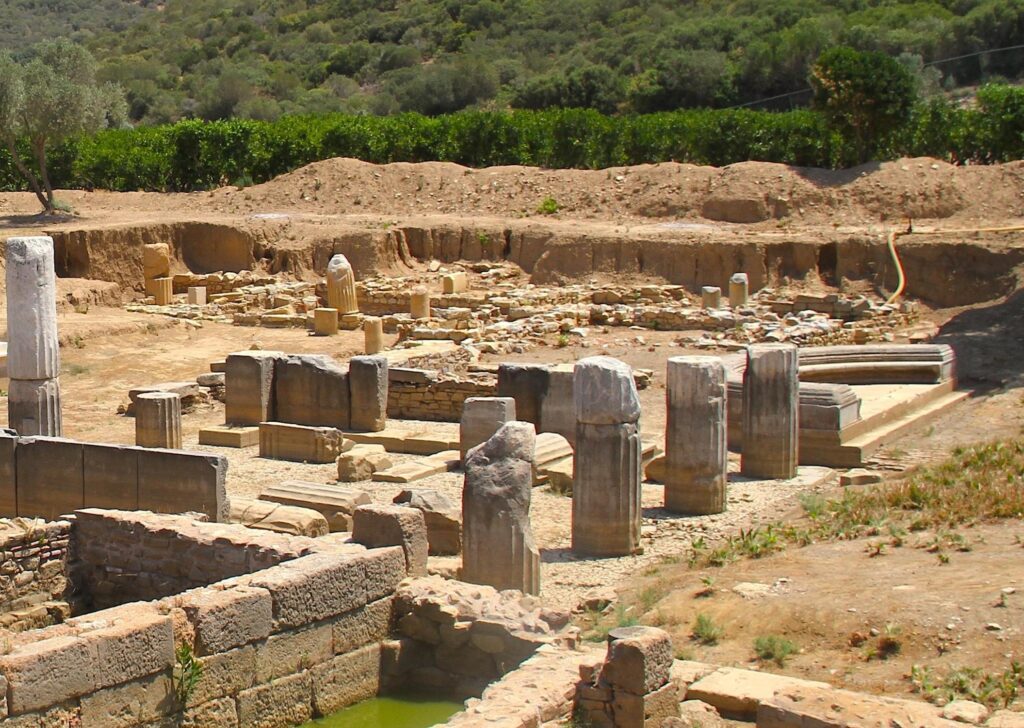

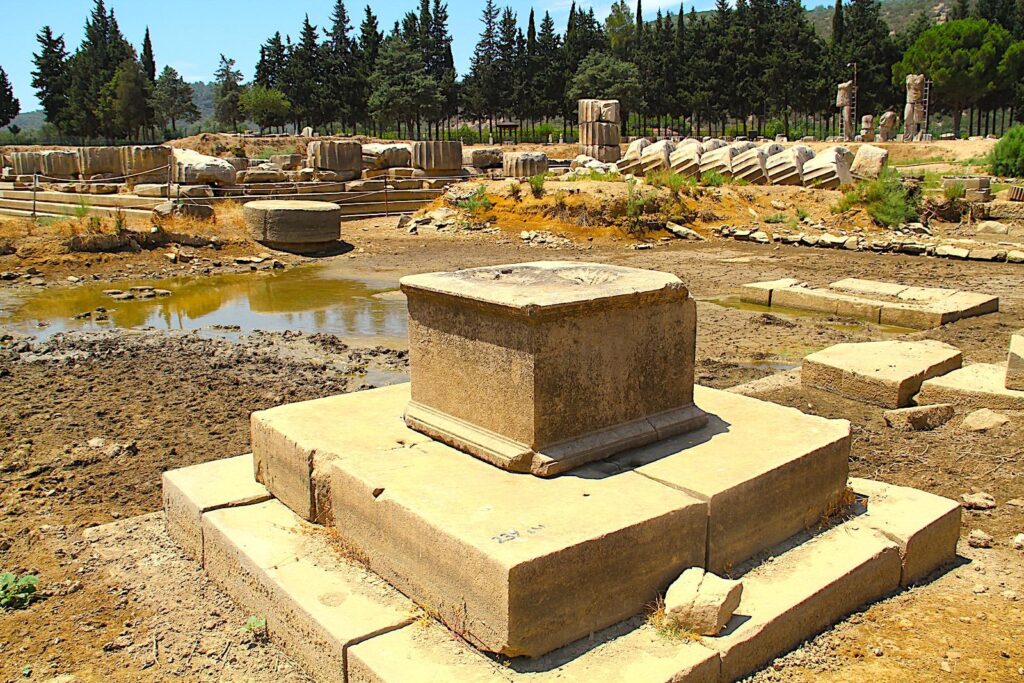
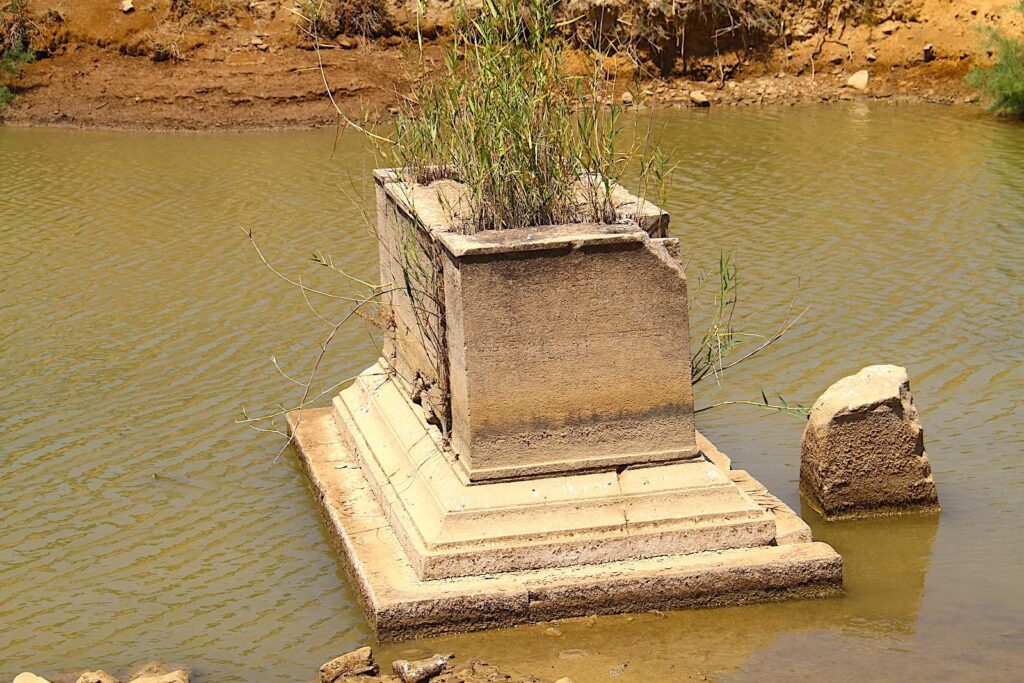
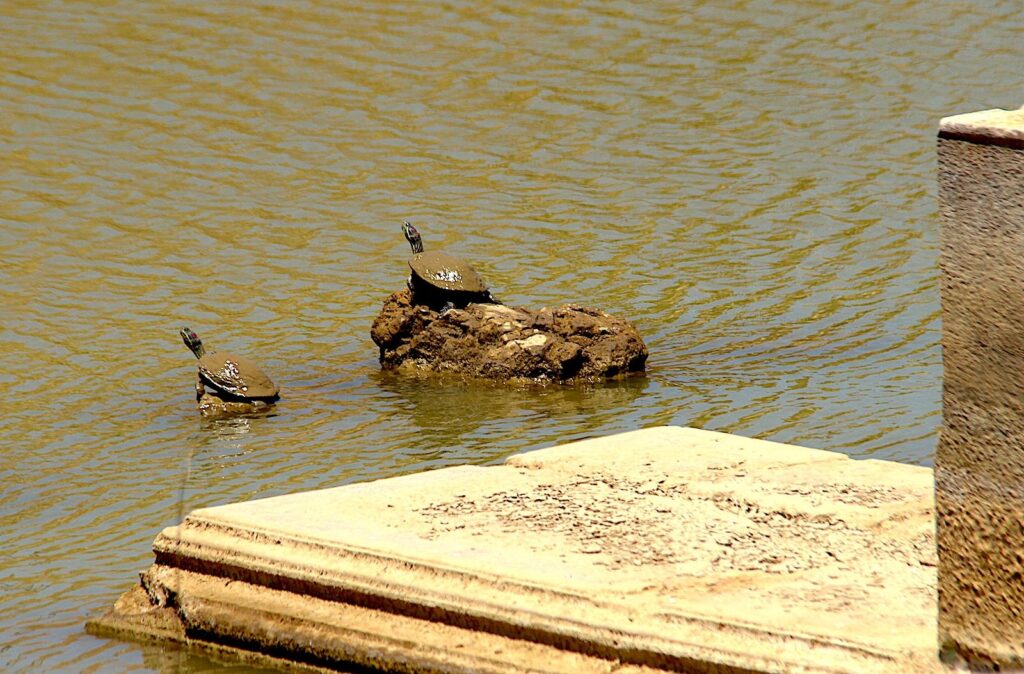
The Turtles at Claros
The turtles at Claros, particularly the “turtle pool” within the sanctuary of Apollo, hold a unique place in the site’s history and mythology. Turtles were often associated with the god Apollo. In Greek mythology, the tortoise is linked to the creation of the lyre, an instrument associated with Apollo. Hermes is said to have invented the lyre from a tortoise shell and gifted it to Apollo. Within the sanctuary, there was a dedicated pool for turtle serving both a practical and symbolic purpose, creating a serene and sacred environment that reflected the peaceful nature of the sanctuary. Their presence at Claros would have been seen as auspicious and reflective of the divine favour.
